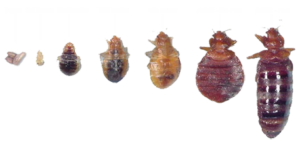
Unfortunately for many, bed bugs are found throughout the world and have become increasingly abundant in recent years, particularly in North America, Europe and Australia, striking all types of residences including homes, hotels, apartments, shelters and even cruise ships. Luckily, understanding why they live in your home may help you to get rid of them more quickly.
Identification
Bed bugs are small, oval and wingless insects that feed on the blood of warm-blooded animals. For this reason, bed bugs are attracted to body heat and to the carbon dioxide in our breath. Adult bed bugs reach 1/4 of an inch in length, while their color ranges from light tan to deep brown. Because of their flat bodies, bed bugs are sometimes mistaken for small cockroaches, ticks or humidity bugs.
Environment
Bed bugs typically reside in areas where people sleep and concentrate near beds, in mattresses, bed frames and box springs. Other places that bed bugs seem to like are dresser corners, curtains and cracks in wallpaper near the bed. However, bed bugs can also live in other areas of the home such as in small cracks and crevices in furniture, textiles and any type of upholstered furniture.
Evidence
The first sign of your home being infested by bed bugs is the presence of itchy inflammation reactions or reddened spots on your skin. Because the bed bugs’ saliva contains both an anesthetic substance and anticoagulant proteins, their bites are undetectable until you discover their effects a few hours later. Another sign of a bed bug infestation is the presence of dark fecal spots, eggs or scale skins in or around the bed. Sometimes, a coriander-like smell can be detected, but only in heavily infested homes.
Avoidance
In order to get rid of a bed bug infestation, it is important to thoroughly examine the bedroom or other infested areas for any signs of bed bugs. A great variety of bed bug sprays, dusts and aerosol insecticides exist and can be applied to all suspected areas, including carpets, walls and mattresses. Dismantling bed frames and furniture, filling cracks in floors and walls and encasing mattresses with special bags can also help in controlling bed bugs. Washing your sheets, covers and clothes in hot water is another useful tip. In extreme cases, pest-control experts may be needed to treat infested areas.
Misconceptions
A common misconception is that bed bugs are a sign of a dirty home. However, bed bugs can be found everywhere regardless of the home’s cleanliness or the hotel’s number of stars. The reason for this is that bed bugs can be transported in luggage, clothes and other items moved from an infected area to a bed bug-free environment. Thus, a good way to avoid bed bug infestation is to make sure that no bed bugs or eggs were transported into your home if bed bug signs were observed during trips or visits. Washing clothes and spraying luggage is a good way to avoid transporting these unwanted visitors into your home.
